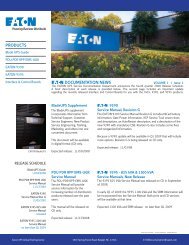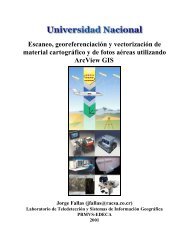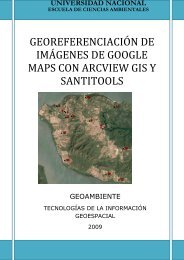Plant Features - Storage Made Easy
Plant Features - Storage Made Easy
Plant Features - Storage Made Easy
You also want an ePaper? Increase the reach of your titles
YUMPU automatically turns print PDFs into web optimized ePapers that Google loves.
Perfect Park-Strips<br />
Weber Basin Water Conservancy District<br />
David Rice<br />
Conservation Programs Manager
Why Water-Wise Landscaping<br />
• Water resources are limited.<br />
• Population growth.<br />
• New water projects are difficult and expensive.<br />
• In Utah, landscape water makes up about 60-<br />
65% of the average residential water use.<br />
• Changes need to be implemented which allow<br />
us to have attractive, appealing landscapes<br />
while maintaining sufficient water supplies for<br />
future use.
Water-wise or Low-Water-Use<br />
Landscaping Basics<br />
• Plan and design<br />
• Know your types of soil<br />
• <strong>Plant</strong> Selection<br />
• Efficient irrigation<br />
• Create practical turf areas<br />
• Use of mulches / hard-scape<br />
• Regular maintenance
Plan and Design<br />
• Probably one of the most important parts of<br />
water-wise landscaping.<br />
• Consider the uses and expectations (function).<br />
• Consider slope, aspect, shade, etc.<br />
(microclimate)<br />
• Hydro-zoning for plant<br />
water requirements<br />
• Soil types<br />
• Hard-scaping<br />
• Irrigation (where, and how).
Know Your Soils<br />
Bottle<br />
Self Test<br />
• Compacted soils need aeration, which will<br />
increase oxygen and break up soil layers.<br />
• If poor in nutrient, then chose plants that are<br />
adapted ( thrive in what you have and use less<br />
fertilizer and amendment).<br />
• USU has a soil lab that can test nutrient levels<br />
and help you determine what may be needed.<br />
• Organic matter will increase the water and<br />
nutrient holding capacity of both sand and clay<br />
soils.<br />
• Clay or sand will determine what you want to<br />
plant and how to water efficiently.<br />
• Some plants prefer rocky, sandy soils with little<br />
nutrient while others may prefer clay. Most<br />
plants are somewhat adaptable and tolerate<br />
different types of soils.
Soil Water Movement<br />
Any change in texture or density can<br />
impede water percolation through soil<br />
Clay layer<br />
A clay, or<br />
compacted<br />
layer creates<br />
saturated or<br />
perched water<br />
layer<br />
Sand layer<br />
A sand layer<br />
impedes water<br />
movement until<br />
overlying layer<br />
is saturated
<strong>Plant</strong> Selection<br />
• Use plants adapted to<br />
your local climate<br />
(possibly natives).<br />
• The native or adapted<br />
plants will require less<br />
water and less<br />
maintenance.<br />
• <strong>Plant</strong>s need to be chosen<br />
for the design based on<br />
similar water needs<br />
(hydro-zoning)
Use Mulches<br />
• Mulches aid in moisture retention and<br />
surface shading.<br />
• Mulches discourage weed growth<br />
• Can provide nutrients over time (depends on<br />
material)<br />
• Materials can include:<br />
Bark, wood chips, pine straw, nut shells,<br />
gravel, crushed stone, or grass clippings.
Irrigate Efficiently<br />
• Proper irrigation saves water and results in<br />
healthier more drought resistant plants.<br />
• Apply the proper amount and only when<br />
needed<br />
• Understand different water requirements for<br />
different areas of the landscape<br />
• Program the system in response to changing<br />
seasonal variations in temperature and rain.<br />
• Monitor your sprinkler system and make<br />
adjustments as needed to get a good uniform<br />
application.
Regular Maintenance<br />
• All landscapes need maintenance to look<br />
good and stay healthy.<br />
• Trim and prune plants regularly<br />
• Control weeds early.<br />
• Minimize fertilizer use to avoid overgrowth<br />
and increased water needs<br />
• Get out in your landscape and enjoy it<br />
while you care for it.
So Why Park-Strips<br />
Small spaces with little<br />
functional value<br />
• Challenges with<br />
soils<br />
• Difficult to water<br />
efficiently<br />
• City utility easements.<br />
• Parade route
Park Strips: Before You Start!<br />
• Check local city codes for restrictions.<br />
• Have a design in mind. What do you<br />
want to achieve Will you cause<br />
neighborhood anxiety<br />
• Are there resources to make it easier<br />
and cheaper Examples, discounts, etc.<br />
• Call Blue Stakes 3 days before you dig<br />
so you don’t hit anything you don’t want<br />
to hit .
Park Strip Specific<br />
• Steps to re-landscape your strip.<br />
1. Start with a plan.<br />
2. Make sure the existing is dead.<br />
3. Removal of Turf/ prep for new design<br />
4. Plan proper irrigation for chosen planting<br />
5. Make this space usable or tie in to yard.<br />
• Follow city ordinances and codes
Dig it up!!
Turf Removal<br />
• Spray turf with Round-Up or other grass killer.<br />
or<br />
• Cover grass with plastic or layers of newspaper<br />
for 3-4 weeks. or<br />
• Remove turf with a sod cutter. then<br />
• Till the area and rake out any debris or large<br />
rocks-unless rocks are what is desired.<br />
• Under some conditions, soil amendments may<br />
be desired.
Proper Irrigation<br />
• Right products for the space<br />
• Drip irrigation, bubblers, micro sprays<br />
• Hydrozoning:- choose plants with a similar<br />
water need. For park strips plants should<br />
be adapted for heat, salt, and low water.<br />
• Irrigation scheduling.
Don’t Flood it!!!
Proper and Efficient Irrigation
Examples of Park Strips<br />
Look for design, plant<br />
selection, potential for<br />
efficient irrigation,<br />
maintenance, and possible<br />
violations of known city<br />
codes.
•
• IMAGE008.JPG
Jordan Valley Water Park Strip on 1300 West
<strong>Plant</strong> Selection<br />
• Choose plants that are low water and<br />
suitable for the site.<br />
• Some park strips may have trees/shade<br />
• Heat tolerant, salt tolerant<br />
• Not too tall, nor too wide<br />
• Choose a plant palette that<br />
provides seasonal interest,<br />
or functionality.
Atlas Daisy- Anacyclus depressus
Basket of Gold- Aurinia saxitile
Blanket Flower<br />
Gaillardia x grandiflora<br />
<strong>Plant</strong> <strong>Features</strong>:<br />
-Prefers full sun<br />
-1 to 2 ft high<br />
-Yellow to orange petals with red<br />
center, or all burgundy.<br />
-Very tolerant of dry conditions. Will<br />
tolerate more or less water.<br />
-Deadhead for extended flowering<br />
-Zones 4 to 8
Blue Flax- Linum perenne
Butterfly Weed- Asclepias tuberosa
Candytuft<br />
Iberis sempervirens<br />
<strong>Plant</strong> <strong>Features</strong>:<br />
-Half-shrubby, dwarf,<br />
spreading, semievergreen.<br />
-April to May its neat<br />
tufts of dark green<br />
change into masses of<br />
snowy white.<br />
-Zone 4-9<br />
-Nice border plant or<br />
rock garden plant.
Catmint- Nepeta faassenii
Chocolate Flower<br />
Berlandiera lyrata<br />
<strong>Plant</strong> <strong>Features</strong>:<br />
-Chocolate scented<br />
-12 in. tall<br />
-Very drought tolerant<br />
-Flowers all summer<br />
-Full sun to light shade<br />
-Low maintenance,<br />
clean up in spring<br />
-Requires no water<br />
once established.<br />
-Zone 5-9
Curry <strong>Plant</strong>- Helichrysum trianschanicum
Daylily- Hemerocallis species
Desert Marigold<br />
Baileya Multiradiata<br />
<strong>Plant</strong> <strong>Features</strong>:<br />
-Short lived perennial<br />
-Desert plant 12 in. tall<br />
-Full sun<br />
-Flowers all summer<br />
-No water once established<br />
-Once yearly cleanup<br />
-Zones 7-10 all zones as annual<br />
But can reseed and grow in<br />
zones 5-6.
Garden Sage –Salvia officinalis
Gooseberry Globemallow<br />
Sphaeralcea grossulariafolia<br />
<strong>Plant</strong> <strong>Features</strong>:<br />
-Grows 4 in. to 3 ft. tall.<br />
-Silvery green foliage.<br />
-Blooms late spring to<br />
summer.<br />
-Full sun.<br />
-One of few native orange<br />
flowering species.<br />
-No water if established<br />
-No real maintenance<br />
-Zones 4-8
-Full sun to partial shade, medium to low<br />
water requirement<br />
-Fast growth, great ground cover for dry<br />
shaded areas. Humming birds love it.<br />
Hummingbird Flower<br />
Zauschneria latifolia <strong>Plant</strong> <strong>Features</strong><br />
-Perennial to 12 in.<br />
-Foliage dark green<br />
-Flowers scarlet<br />
-Flowers midsummer<br />
through frost<br />
-No water needed once<br />
established.<br />
-Once per year cleanup is<br />
all that is needed.<br />
-Zone 4-10
Sunset Hyssop<br />
Agastache rupestris<br />
<strong>Plant</strong> <strong>Features</strong>:<br />
-Height 20-24 in.<br />
-Width 18 in.<br />
-Blooms late summer<br />
through frost<br />
-Orange to pink blossoms<br />
-Very fragrant (root beer)<br />
-Full sun to part shade<br />
-Water every 7-14 days<br />
-Only maintenance is<br />
one time yearly cleanup.<br />
-Zones 4-10 up to 7000 ft.
Mesa Verde Iceplant<br />
Delosperma ‘Kelaidis’<br />
<strong>Plant</strong> <strong>Features</strong>:<br />
-Low growing to 3 in.<br />
-Flowers spring to Fall<br />
-Very nice rock garden<br />
plant.<br />
-Dense mat forming<br />
-Zones 5-9
Hardy Iceplant<br />
Delosperma nubigenum<br />
<strong>Plant</strong> <strong>Features</strong>:<br />
-Creeping, mat forming<br />
succulent perennial<br />
-Brilliant yellow flower in<br />
mid spring<br />
-Full sun<br />
-Zones 5-9
English Lavender<br />
Lavandula angustifolia ‘Hidcote’<br />
<strong>Plant</strong> <strong>Features</strong>:<br />
-Full Sun<br />
-Late spring-summer<br />
bloomer<br />
-Used as herb for oils,<br />
fragrance, kitchen,<br />
crafts, etc.<br />
-1 to 2 ft tall and wide<br />
-Dead head and cut<br />
back yearly for best look<br />
-Water once per week.<br />
-Zones 5-8
Missouri Primrose- Oenothera missouriensis
Desert Four O’clock<br />
Mirabilis multiflora<br />
<strong>Plant</strong> <strong>Features</strong>:<br />
-Perennial to 2’ tall from a tuber<br />
-Comes from base in late spring<br />
-Lush, dark green leaves<br />
-Flowers midsummer to frost<br />
-Breaks off at base after frost for<br />
easy fall or spring clean up.<br />
-From 2300-7500 ft<br />
-Full Sun, good drainage, low water<br />
requirement, no water once established<br />
-Fast growing, flowers first year from seed<br />
-Requires a lot of room (8 ft. wide)
Paperflower- Psilostrophe backeri
Penstemon Species
Rocky Mountain Penstemon<br />
Penstemon strictus<br />
<strong>Plant</strong> <strong>Features</strong>:<br />
-Perennial, low water use<br />
-2 to 3 ft tall and wide<br />
-Spring blooming (May)<br />
-Full sun<br />
-Cut back when flowering<br />
has finished.<br />
-Water every 7-10 days.<br />
-Zone 3-8
Bridge’s Penstemon<br />
Penstemon rostriflorus<br />
<strong>Plant</strong> <strong>Features</strong>:<br />
-Full sun<br />
-2 to 3 ft tall and wide.<br />
-Mid-summer bloomer,<br />
blooms last a long time.<br />
-Very drought tolerant.<br />
-Moderate water while in<br />
bloom, none thereafter.<br />
-Yearly cut back for<br />
maintenance.<br />
-Zones 3-9
Pineleaf Penstemon<br />
Penstemon pinifolius sp.<br />
<strong>Plant</strong> <strong>Features</strong>:<br />
-Full sun<br />
-Mid summer bloomer<br />
-Yellow or red<br />
-12 to 15 in tall, 18 wide<br />
-No water once established<br />
-Once yearly cleanup<br />
-Zones 4-9
Firecracker Penstemon<br />
Penstemon eatonii<br />
<strong>Plant</strong> <strong>Features</strong>:<br />
-Early spring bloom<br />
-Beautiful red<br />
-1 to 3 ft tall and wide<br />
-Prefers poor nutrient soils,<br />
will rot with organic<br />
mulches.<br />
-No water once established<br />
-Dead head spent flowers<br />
for nice foliage through<br />
summer.<br />
-Zones 4-9
Red Rocks Penstemon<br />
Penstemon x mexicali ‘Red Rocks’<br />
<strong>Plant</strong> <strong>Features</strong>:<br />
-Full sun to part shade<br />
-2 ft tall 2 ft wide<br />
-Bright flowers all summer<br />
when dead headed<br />
-Moderate water for lasting<br />
blooms.<br />
-Water every 7-14 days<br />
-Zones 4-8
Palmer’s Penstemon<br />
Penstemon palmeri<br />
<strong>Plant</strong> <strong>Features</strong>:<br />
-Perennial 4-5 ft tall<br />
-White to pink flower<br />
-Blooms spring and<br />
early summer<br />
-Very fragrant, bee attractor<br />
-Semi evergreen<br />
-Prefers sandy soil<br />
-Will grow in clay with no<br />
additional water<br />
-Cut spent blooms for<br />
attractive summer foliage<br />
-Zones 3-10
Pink Pussy Toes- Antennaria rosea
Red Valerian or Jupiter’s Beard<br />
Centranthus ruber<br />
<strong>Plant</strong> <strong>Features</strong>:<br />
-Full sun to part shade<br />
-2 to 3 ft tall<br />
-Summer bloomer<br />
-Also a white variety<br />
-Will tolerate lower<br />
water use but not in<br />
extended heat spells.<br />
-Zones 5-9
May Knight Sage<br />
Salvia nemorosa ‘May Knight’<br />
<strong>Plant</strong> <strong>Features</strong>:<br />
-Full sun to part shade<br />
-18-24 in tall and wide<br />
-Blooms mid summer<br />
-Continued bloom when<br />
cut back<br />
-Water every 7-10 days<br />
-Zone 5-9
Sun Rose –Helianthemum nummularium
Creeping Thyme<br />
Thymus species<br />
<strong>Plant</strong> <strong>Features</strong>:<br />
-Low growing mat<br />
forming<br />
-Flowers spring-early<br />
summer<br />
-Full sun<br />
-Zones 4-9
Coral Canyon Twinspur<br />
Diascia integerrima<br />
<strong>Plant</strong> <strong>Features</strong>:<br />
-Summer blooming<br />
-12 in. tall<br />
-Pink to purplish<br />
blooms<br />
-Full sun<br />
-Blooms longer with a<br />
little extra water. Once<br />
per week watering<br />
-Zones 5-9
Mulches<br />
Benefits:<br />
-No water<br />
-Color and texture<br />
differences<br />
-Aesthetic appeal<br />
and variation<br />
-Many materials can<br />
be used:<br />
Nut shells<br />
Grass clippings<br />
Rock<br />
Bark
Why<br />
• Water is a precious resource<br />
• Park strips are difficult to water efficiently.<br />
• There is no functional use for turf in this<br />
space. (except parade routes-once a year)<br />
• They can be done very attractively, meet<br />
city codes and save water, while reducing<br />
maintenance.<br />
• It makes your yard unique!! (Unless<br />
you prefer a nice paint color for your<br />
home)
Resources<br />
• “Rip your strip”- Program by Utah Rivers<br />
Council<br />
• Water District Gardens for examples<br />
• Internet<br />
• USU extension







